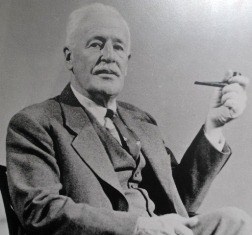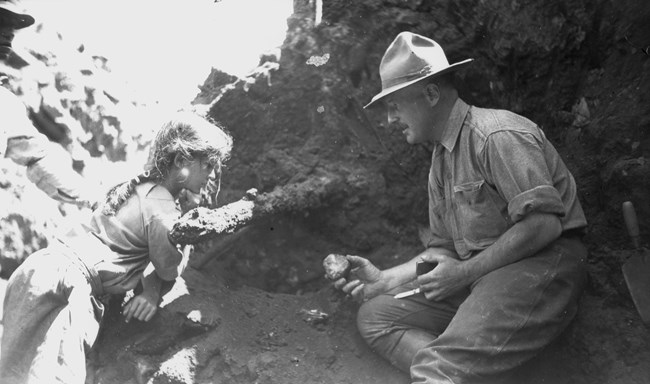
NPS Photo Introduction 
Laboratory of Anthropology Photo In 1914, Kidder became one of the first archaeologists to earn a Ph.D. in the United States, and the first to concentrate on the Southwest. Soon thereafter, he was invited by the Phillips Academy of Andover, Massachusetts to develop a multi-year archaeological project in the Southwest that would "be large enough, and of sufficient scientific importance, to justify work upon it for a number of years." Kidder decided that Pecos would be an ideal site for such a project. The large variety of ceramic types that had been identified there would enable him to use stratigraphic evidence to establish a sequence of pottery types. This would make it possible to establish a chronology of architectural data, burials, and other details of ancestral Pueblo culture. In addition, as the easternmost Pueblo settlement in close trading contact with Plains tribes, Pecos had been continuously occupied from the 1200s until 1838, and its history had been well documented since the time of Coronado. From 1914 to 1929, Kidder conducted research and excavations at Pecos, the first such long-term multidisciplinary project in Southwestern archaeology. Through the use of stratigraphic methodology, even before the advent of today's more sophisticated techniques such as tree-ring and carbon-14 dating, Kidder was able to establish a chronological sequence of ancestral Puebloan occupation throughout the Southwest that is still largely accepted today. Kidder spent the entire first season in 1914 excavating the refuse midden on the east side of the North Pueblo. He found, as expected, that the undisturbed rubbish was stratified, with the earliest remains at the lower levels. "The beds of rubbish," he wrote, "were repositories for ashes, house-sweepings, table-leavings, broken pottery, and discarded implements; they served, as well, for the burial of the dead." Over the next fifteen years, together with his wife Madeleine and his field crews, he explored the middens, the pueblo buildings, the mission church, and nearby sites at Pecos. In keeping with the archaeological practices of the times, he shipped thousands of artifacts back to the Robert S. Peabody Museum of Archaeology at Phillips Academy in Andover, and thousands of human remains to the Peabody Museum of Archaeology and Ethnology at Harvard University. 
NPS Photo In August, 1927, Kidder invited "all the eminent archaeologists and ethnologists of the time" to join him for a three day conference at Pecos to pool their knowledge and discuss fundamental problems of Southwestern archaeology. He wanted to formulate plans for future work in the region and establish a "unified system of nomenclature" for the different periods of ancestral Puebloan culture. At this first Pecos Conference, the participants agreed upon the "Pecos Classification," terms for chronologically sequent periods that are fairly distinct and distinguishable in the archaeological record. These classifications remain in common use today: Basket Maker I, II, and III, and Pueblo I, II, III, IV, and V. The Pecos Conference soon became an annual institution for Southwestern archaeologists, convening each summer at archaeological sites in the region, and once every five years at Pecos. 
Laboratory of Anthropology Photo In 1929 Kidder joined the Carnegie Institution of Washington, and spent the remainder of his career studying Mayan archaeology in Peru, Mexico, and Guatemala. Kidder died in 1963 and he and his wife are buried in the park, near one of the sites he excavated. "It will never be known," wrote one biographer, "how many students and colleagues he helped with friendly counsel, advice, and encouragement that enabled them to start or continue careers in archaeology and in other fields as well."
The Legacy Kidder introduced and used methods and techniques that were accepted at the time, but the field of archaeology continues to evolve and some procedures that were common in earlier eras are no longer practiced. In 1990, Congress passed the Native American Graves Protection and Repatriation Act (NAGPRA), requiring all federal museums and those receiving federal funding to return all human remains and funerary artifacts to their affiliated tribes. In 1999, the Peabody Museum returned the human remains sent to them by Kidder and they were reinterred at the park. Many artifacts from the Robert S. Peabody Museum have been repatriated to the descendants of the Pecos people at Jemez Pueblo, and others are maintained at the park on long-term loan from the museum. Although some of A. V. Kidder's work has been superseded by more modern methodologies, much remains intact. His exacting methods and procedures paved the way for much of today's archaeological work in the Southwest. Want to learn more? Return back to the History Timeline.
Sources: Flint, Richard, and Shirley Cushing Flint, "Alfred V. Kidder," Office of the New Mexico State Historian web site http://newmexicohistory.org/people/alfred-v-kidder (no date) Givens, Douglas R., Alfred Vincent Kidder and the Development of American Archaeology (Univ. of New Mexico Press, 1992) Goldberg, Carey, "Pueblo Awaits its Past in Bones From Harvard," New York Times, May 20, 1999. Kidder, Alfred V., "The First Season of Field Work at Pecos," reprinted in Woodbury (1973), op. cit., at pp. 108-112 _______, "Reminiscences in Southwest Archaeology: I," Kiva, Vol. 25, No. 4 (Apr., 1960), pp. 1-32 _______, "Southwestern Archeological Conference," reprinted in Woodbury (1973), op. cit., at pp. 113-116, from Science 66:489-91 Reed, Judy, "Repatriation and Reburial of Ancestors Case Study," National Park Service web site https://www.nps.gov/partnerships/repatriation_pecos.htm (2004) Woodbury, Richard B., Alfred V. Kidder (Columbia Univ. Press, 1973) _______, "Looking Back at the Pecos Conference," Kiva, Vol. 48, No. 4 (Summer, 1983), pp. 251-266 [Prepared by Volunteer in Park Bruce Herr, November 2016] |
Last updated: October 29, 2021
